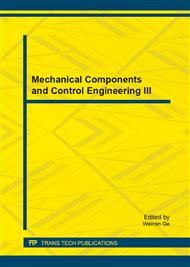[1]
El-Badawy, S.M., et al. Comparison of Idaho pavement design procedure with AASHTO 1993 and MEPDG methods. in 1st Congress of the Transportation and Development Institute of ASCE, March 13, 2011 - March 16, 2011. 2011. Chicago, IL, United states: American Society of Civil Engineers (ASCE).
DOI: 10.1061/41167(398)56
Google Scholar
[2]
Rodezno, M.C. and K.E. Kaloush, Comparison of asphalt rubber and conventional mixture properties: Considerations for mechanistic-empirical pavement design guide implementation. Transportation Research Record, 2009(2126): pp.132-141.
DOI: 10.3141/2126-16
Google Scholar
[3]
Archilla, A.R. and L.G. Diaz, Effects of asphalt mixture properties on permanent deformation response. Transportation Research Record, 2011(2210): pp.1-8.
DOI: 10.3141/2210-01
Google Scholar
[4]
Daniel, J.S., G.R. Chehab, and D. Ayyala. Sensitivity of RAP binder grade on performance predictions in the MEPDG. in Asphalt Paving Technology 2009, AAPT, March 15, 2009 - March 18, 2009. 2009. Minneapolis, MN, United states: Association of Asphalt Paving Technologist.
Google Scholar
[5]
Diefenderfer, S.D. Evaluation of the MEPDG using asphalt material inputs obtained from plant mix. in Asphalt Paving Technology 2011, AAPT, March 27, 2011 - March 30, 2011. 2011. Tampa, FL, United states: Association of Asphalt Paving Technologist.
DOI: 10.12783/aapt2018/33805
Google Scholar
[6]
Mogawer, W.S., et al., Evaluation of the effects of hot mix asphalt density on mixture fatigue performance, rutting performance and MEPDG distress predictions. International Journal of Pavement Engineering, 2011. 12(2): pp.161-175.
DOI: 10.1080/10298436.2010.546857
Google Scholar
[7]
Singh, D., M. Zaman, and S. Commuri, Evaluation of dynamic modulus of modified and unmodified asphalt mixes for different input levels of the MEPDG. International Journal of Pavement Research and Technology, 2012. 5(1): pp.1-11.
Google Scholar
[8]
Thyagarajan, S., et al. An evaluation of the effects of nonlinear load-strain behavior on MEPDG analysis of flexible pavements. in Asphalt Paving Technology 2009, AAPT, March 15, 2009 - March 18, 2009. 2009. Minneapolis, MN, United states: Association of Asphalt Paving Technologist.
Google Scholar
[9]
Wielinski, J.C. and G.A. Huber. Evaluation of French high modulus asphalt (EME) in pavement structural design (MEPDG). in Asphalt Paving Technology 2011, AAPT, March 27, 2011 - March 30, 2011. 2011. Tampa, FL, United states: Association of Asphalt Paving Technologist.
DOI: 10.12783/aapt2018/33800
Google Scholar
[10]
NCHRP, Research results digest 290, July 2004, National Cooperative Highway Research Program.
Google Scholar


